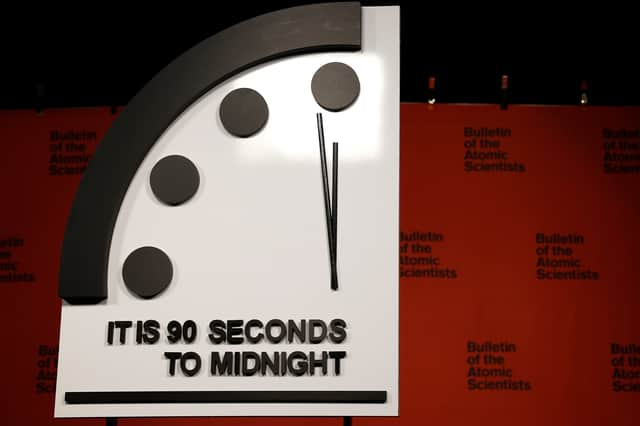Doomsday Clock: what is the current clock time in 2024, what is the Doomsday Clock, announcement - and meaning


For the second consecutive year, the Doomsday Clock has held steady at 90 seconds to midnight.
The decision to maintain the same setting from last year reflects the belief of the clock's custodians at the Bulletin of the Atomic Scientists that the risk of a global apocalypse has not diminished over the past 12 months.
Advertisement
Hide AdAdvertisement
Hide AdThe Bulletin pointed to several factors influencing the decision. Ongoing conflicts in Ukraine and Gaza were highlighted as contributing to the sustained threat level, and the Earth's record-breaking temperatures, marking the hottest year on record, were cited as alarming indicators of the environmental challenges that persist.
But what exactly is the Doomsday Clock? When was it devised, and what does it mean for humanity? Here is everything you need to know about it.
What is the Doomsday Clock?
The Doomsday Clock is a symbolic representation of the world's proximity to a global catastrophe, particularly nuclear war.
Conceived by the Bulletin of the Atomic Scientists - a nonprofit organisation founded in 1945 by Albert Einstein and former Manhattan Project scientists - the clock was first introduced in 1947 in the aftermath of the dropping of atomic bombs on Hiroshima and Nagasaki.
Advertisement
Hide AdAdvertisement
Hide AdThe clock's hands are adjusted periodically to reflect the perceived level of threat to humanity, with midnight representing the metaphorical "doomsday."
The Doomsday Clock was initially set at seven minutes to midnight in 1947, symbolising the world's perceived closeness to a nuclear apocalypse.
Since its inception, the clock has undergone numerous adjustments, considering not only nuclear threats but also other existential risks such as climate change and emerging technologies.
The clock's setting is determined by the Bulletin of the Atomic Scientists' Science and Security Board, in consultation with the Bulletin's Board of Sponsors, which includes a group of Nobel laureates.
Advertisement
Hide AdAdvertisement
Hide AdThe decision-making process takes into account global events, scientific advancements and political developments that impact the likelihood of catastrophic events. The factors influencing the clock's setting are diverse, encompassing geopolitical tensions, arms control agreements, environmental concerns, and technological advancements.
During periods of heightened international tension, the clock tends to move closer to midnight. For instance, the Cuban Missile Crisis in 1962 prompted the clock's hands to be set at two minutes to midnight.
Conversely, improvements in international relations, arms reduction treaties, and global efforts to address climate change have led to adjustments moving the clock farther away from midnight.
However, the Doomsday Clock has been getting closer to midnight since 1991, when it was set to 17 minutes to midnight, after the United States and the Soviet Union reached an agreement on nuclear arms reductions.
Advertisement
Hide AdAdvertisement
Hide AdIn recent years, the Doomsday Clock has increasingly considered climate change as a significant factor in setting the time, as scientists recognise the potential for environmental disasters to cause widespread harm and disruption.
The Doomsday Clock was set at 100 seconds to midnight in 2020, where it stayed for the next three years, But in January 2023, the hands were set to just 90 seconds to midnight, partly to reflect the mounting dangers of the war in Ukraine.
Comment Guidelines
National World encourages reader discussion on our stories. User feedback, insights and back-and-forth exchanges add a rich layer of context to reporting. Please review our Community Guidelines before commenting.
